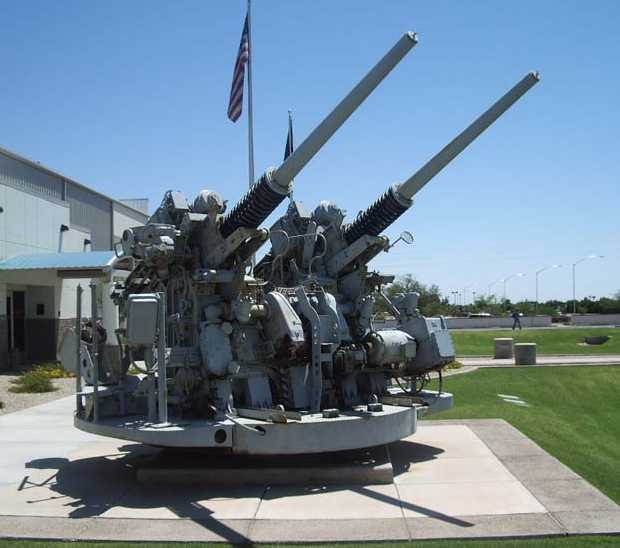|
The weapon chosen was the standard 3"/50 (7.62 cm) Mark 22 which was used on many Destroyer Escorts and auxiliaries built during the latter part of World War II. This was the smallest-caliber weapon which could still use the VT fuzes available at the time. It also had a concentric counter-recoil spring, which meant that it was more easily adapted for automatic fire. Automatic fire was achieved with an electrically driven auto-loader using revolving sprockets. BuOrd rushed this through the design phase, with the first prototype being ready for test firing on 1 September 1945. The end of the war slowed development and resources were diverted to the more potent 3"/70 (7.62 cm) design. As a result, it was not until 1948 that this weapon was delivered to the fleet in quantity. Although completed too late for service during World War II, this weapon was widely used on many USA ships from the late 1940s through to the 1980s and remains in service today (2009) on a few USA ships sold to other nations and on the Norwegian Oslo Class frigates. The Spanish firm of Fabrica de Artilleria, Sociedad Española de Construccion Naval manufactured these guns under license for the Spanish Navy. Dimensionally, the new twin 3"/50 (7.62 cm) mounting was the same size as the quad 40 mm Bofors mounting, although it weighed a bit more. The additional weight meant that these guns replaced the Bofors guns on a one for three basis, rather than the originally intended one for two basis. Ammunition was loaded from each side into the auto-loader. The sprockets turned intermittently, transporting the rounds to a loading tray, which swung down to be in line with the breech where a rammer then catapulted the rounds directly into the firing-chamber, with the breech-closing mechanism being triggered by the edge of the cartridge case as it tripped one of the ejectors. Effectively, the auto-loader simply replaced the crewmen whose job it was to push shells into the breech. The auto-loader is synchronized with the rhythm of the recoil motion, so that new rounds are ready to be rammed at the instant that the previous cartridge is ejected. Ballistically, the new automatic weapon had the same characteristics as the older weapon, although the higher rate of fire did result in a shorter barrel life. It is possible that these guns on USS Biddle (DLG-34) damaged a Mig fighter in the Tonkin Gulf on 19 July 1972. Constructed with an autofretted monobloc barrel with chromium plating and secured at the breech by a bayonet joint. Uses an automatic breech block. The mechanical and electrical complexity of this weapon were near the limits of World War II technology and excellent servicing is required to keep it in operation. However, it did give greatly improved performance against likely aircraft targets, with testing showing that against a target representing a Nakajima plane a single rapid-fire 3"/50 (7.62 cm) was as effective as two 40 mm quad mountings and that it could effectively engage at a much longer range. As per the nomenclature change in the US Navy after World War II, these weapon designations are for the mountings, not the gun itself. The gun barrel was the Mark 22 first produced during World War II. Mark 27 was the original twin mount, Mark 33 was an improved twin mount with a different slide and Mark 34 was the single mount version. Munitions are currently (2001) being produced by Simmel Difesa (Italy), Nammo Raufoss (Norway) and EXPA (Spain). |

3"/50 (7.62 cm) Mark 33 at Confederate
Air Force Museum, Mesa, AZ
|
| .
|